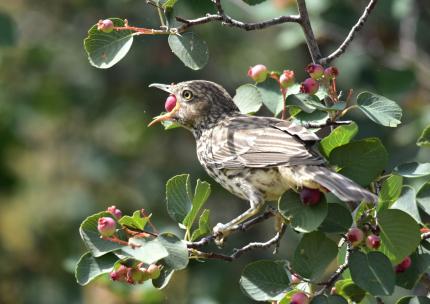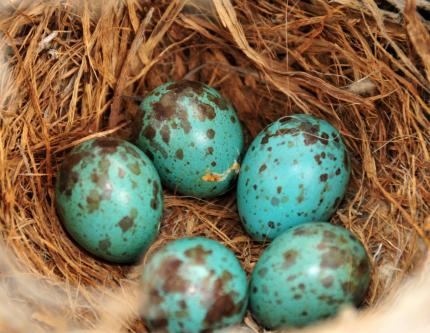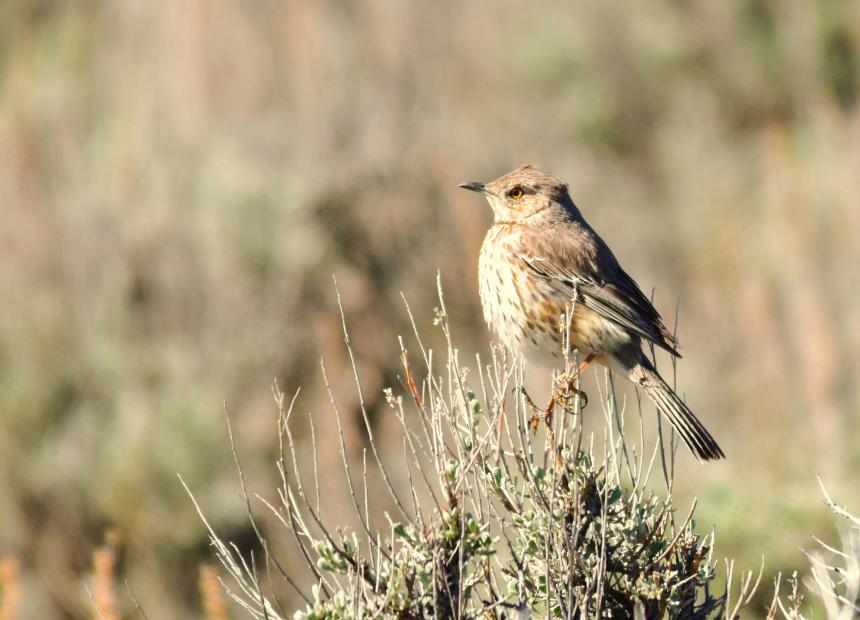Moderate-
High
The population of sage thrasher in Washington is low. The sage thrasher is a sagebrush obligate and is vulnerable to population declines and range contractions due to loss or degradation of shrubsteppe habitat.
Description and Range
Physical description
This medium-sized songbird is distinguished from other thrashers by its smaller size (8 to 9 inches), short and straight bill, and relatively short tail. Male and female are similar in appearance. The upper body is drab, brownish-gray with slightly darker feathers forming indistinct streaks, particularly on the crown. The sage thrasher is the only thrasher species that breeds in Washington. The thrasher often sings melodious, complex songs from atop tall shrubs.
Ecology and life history
Sage thrashers are generally dependent on large patches and expanses of sagebrush for breeding, but will use small fragments of sagebrush among agricultural fields. This species does not use other habitats for foraging or nesting, but sometimes uses other habitats, such as riparian areas, during dispersal and migration.

Sage thrashers typically forage on the ground. During migration and on the wintering areas, this species’ diet includes arthropods, fruits, and can include mistletoe. In its breeding area, this species’ diet consists of insects — a large portion of that diet contains ants and ground beetles.
In the shrubsteppe, there can be extreme daily fluctuations in temperature. Sage thrashers nest beneath shrubs or on the ground and often orient their nest entrances eastward to capture solar heat in the cold mornings and to shade the eggs in the hot afternoons. Sage thrashers may raise two broods annually.

Geographic range
This species is found throughout the Columbia Basin, primarily in areas with a substantial amount of sage. In those limited areas the species is a common breeder. Sage thrashers are not present in the Methow Valley and are locally distributed and uncommon in Okanogan Valley. From 1966 to 2013, U.S. Geological Survey - Breeding Bird Survey data indicated downward trends at the scale of the Great Basin and individual states (Idaho, Nevada, Oregon, and Utah), although the trend in Washington was stable, where reliability was moderate compared to high reliability in all other states and the province. In the period of 2003 to 2013, the trend was stable in all states noted above and the Great Basin. The size of Washington’s breeding population is unknown.
For a map of range-wide distribution and conservation status of this species, check out NatureServe Explorer.
Climate vulnerability
Sensitivity to climate change
Moderate-
High
As sagebrush obligates, sage thrashers are sensitive to climate changes that affect the extent of sagebrush habitat. Increasing fire frequencies, which are perpetuated by invasive species (e.g., cheatgrass), may reduce breeding habitat. Invasive species also degrade foraging opportunities in the sagebrush understory. Warming temperatures, precipitation variability, and drought are also likely to contribute to reductions in sagebrush habitat, negatively affecting sage thrasher reproduction and foraging.
Exposure to climate change
Moderate
- Increased invasive weeds
- Altered fire regimes
- Increased temperatures
- Changes in precipitation
- Drought
Conservation
Conservation Threats and Actions Needed
- Fish and wildlife habitat loss or degradation
- Threat: Habitat loss and fragmentation to residential development, burning, herbicide and pesticide treatments.
- Action Needed: Protect habitat; control cheatgrass; identify degraded habitat for restoration.
- Agriculture and aquaculture side effects
- Threat: Habitat loss and fragmentation to agricultural conversion, burning, herbicide and pesticide treatments.
- Action Needed: Protect habitat; identify degraded habitat for restoration; evaluate U.S. Department of Agriculture Conservation Reserve Program (CRP) leases to provide functional habitat on private lands.
- Threat: Habitat degradation due to intensive grazing by livestock.
- Action Needed: Develop and promote best management practices for grazing in shrubsteppe habitat; protect habitat; control cheatgrass; identify degraded habitat for restoration; identify ways to reduce intensive grazing pressure; evaluate CRP leases to provide functional habitat on private lands.
- Invasive and other problematic species
- Threat: Invasion by cheatgrass and other exotic plants degrades the ecological integrity of the habitat.
- Action Needed: Control cheatgrass; identify degraded habitat for restoration; evaluate CRP leases to provide functional habitat on private lands.
- Resource information collection needs
- Threat: Need to assess ecological integrity of existing shrubsteppe for sage thrasher.
- Action Needed: Conduct studies on use of sagebrush patches in landscapes of differing patchiness to support design of conservation strategy.
See the Climate vulnerability section for information about threats posed by climate change to this species.
Resources
References
Reynolds, T. D., T. D. Rich, and D. A. Stephens. 1999. Sage Thrasher (Oreoscoptes montanus). Birds of North America 463: 1-24.
Vander Hagen, W. M. 2005. Sage Thrasher (Oreoscoptes montanus). Pp 299 - 300 in T. R. Wahl, B. Tweit, and S. G. Mlodinow (eds.) Birds of Washington: Status and Distribution. Oregon State University Press, Corvallis, OR, USA. 436 pp.
